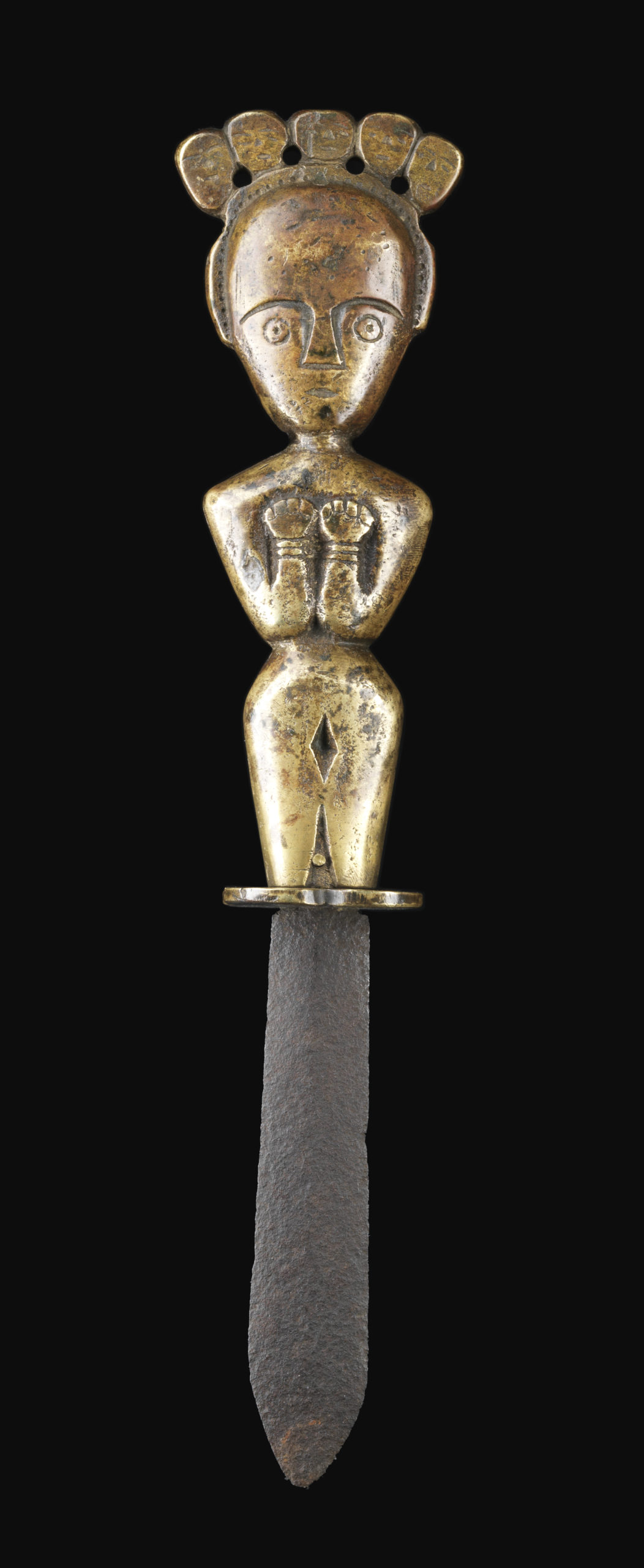Shaman Dagger
The large handle of this dagger, shaped like a human figure, is made of bronze, the blade of iron or steel. Five small human heads can be seen on the head, possibly indicating offspring and fertility, but possibly also in the context of headhunting (which is related). According to the traditional view, bronze knives, azure stone beads (or amulet stones) and a special kind of ceramic vessels are the “Three Treasures” of the Paiwan tribe. In former times they were exclusively in the possession of high-ranking noblemen and tribal leaders (or female leaders; the Paiwan are matriarchally organised) and had been inherited from the ancestors. Usually they were never touched by ordinary people. They were only brought out of the ancestral shrines at the great five-yearly main festivals (maleveq) and were presented to the ancestors, who were temporary guests in the world of the living from the ethereal sphere on this occasion. This trinity of knife/sword, pearl and vessel inevitably brings to mind the Dayak of Borneo, where a special type of symmetrical dagger sword (dohong), ancient pearls and the sacred vessels jawet have a similarly profound meaning. The state treasures of Japan, sword, mirror and jewels, are also related; the vessel and the mirror are partly synonymous in their meaning as a gate to the afterlife and medium for prophecies. So this is probably a very old Austronesian tradition, which has its origins in the Bronze Age.
The Paiwan themselves cannot say anything certain about the origin of the daggers; they only know that they are sacred and have been passed on from ancestors to later generations. Taiwan has no tin deposits and no brass traditions; it can therefore be considered certain that these objects are not originally Taiwanese. Some assumptions tend to the direction that bronze daggers of this kind have their origin in the Dong S`on culture in Dongshan / Vietnam, from which daggers with anthropomorphic handles are known. However, Dong-Son daggers are completely made of bronze and have a slightly different habitus. More likely, local derivatives of Han weapons can be seen as the origin of Taiwan bronze daggers.
The bronze daggers are essentially different from the tacit or rinarug combat and sword knives commonly used by the Paiwan (on Luzon one knows the binalong / hinalong and further south in the Philippines the binangon, which are apparently related terms for old blade weapon forms). They had no practical function, but embodied status and legitimation. Two of the finest known examples of this very rare type of dagger are kept in the Shunye Museum of Aboriginal Art in Taipei and in the Sankokan Museum of Tenri University in Japan. The age is completely uncertain; it can be very high and go back to the first millennium C.E.
| Object | Shaman dagger |
| Culture | Formosa / Southern, Paiwan groups |
| Time | 10th – 18th century (?), undateable |
| Dimensions | Length 37 cm |
| Material | Brass, steel |





